Gold prices have surged dramatically in 2025, increasing over 60% this year alone, raising questions about whether the asset is in a bubble. With significant influences from macroeconomic factors and investor sentiment, understanding the dynamics of gold’s recent performance is essential for both current and prospective investors.

Table of Contents
Key Facts
Recent developments in the gold market include a notable increase in gold’s value, which has seen a doubling since early 2024. This rise has led to polarized opinions among investors: some view gold as a hedge against inflation and government spending, while others criticize it as a non-productive asset.

Analysis and Interpretation
The recent surge in gold prices can be attributed to a combination of macroeconomic factors, including rising debt levels among governments and concerns about economic growth. Bill Gross described gold as a ‘momentum/meme asset,’ indicating that its current price trajectory may be driven more by market sentiment than by traditional valuation metrics. Investors are increasingly nervous about the sustainability of economic growth, especially in light of potential budget deficits and the slowing economy, which further drives demand for gold as a safe haven.
Moreover, the fear of missing out (FOMO) phenomenon appears to be influencing investor behavior, as evidenced by the rapid price increases. The historical context of gold’s performance also plays a role; while it has been a reliable hedge during periods of high inflation, its lack of cash flow and earnings makes it a less attractive long-term investment compared to equities.
Warren Buffett’s historical criticism of gold underscores the argument that it is a speculative asset, lacking intrinsic value. He has consistently advocated for investments that generate cash flow and possess fundamental value, contrasting sharply with gold’s speculative nature. This perspective is echoed by investors who prefer productive assets that create value over time.
Market Impact
The implications of rising gold prices extend across various asset classes. In equities, sectors perceived as safe havens, such as utilities and consumer staples, may benefit from heightened volatility in the broader market. Conversely, growth sectors may suffer as investors shift their focus towards gold and other precious metals.
In the currency markets, the dollar’s stability amid rising gold prices indicates a cautious investor sentiment, with potential implications for currency pairs like EUR/USD and AUD/USD. The bond market is also reacting to these dynamics; as gold prices rise, there is a tendency for bond yields to fluctuate, reflecting investor uncertainty about future interest rates and inflation.
Additionally, commodities other than gold, like silver and platinum, have also seen price increases, suggesting a broader trend in precious metals. However, the sustainability of these trends remains in question amid the potential for overextension in gold prices.
Scenarios
The outlook for gold can be viewed through several potential scenarios:
Base scenario
Gold continues to rise in nominal terms, supported by ongoing economic uncertainty and potential Federal Reserve rate cuts, reaching around $5,000 per ounce by the end of 2026.
Optimistic scenario
If inflation continues to rise and geopolitical tensions escalate, gold could surge to unprecedented levels, potentially exceeding $10,000 per ounce by the end of the decade.
Pessimistic scenario
If economic growth stabilizes and investor sentiment shifts back towards equities, gold prices could experience significant declines, possibly returning to levels below $3,000 per ounce.
Conclusion
The current surge in gold prices has raised critical questions about whether the asset is in a bubble. While there are compelling arguments for gold’s role as a safe haven amid economic uncertainty, the speculative nature of its recent price movements warrants caution. Investors should remain vigilant, considering both the historical context and current market dynamics when making investment decisions.
